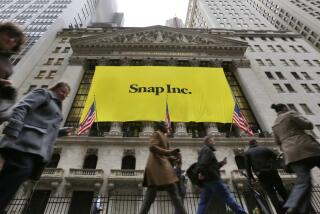Competition Heats Up for Slice of Biotech Industry
- Share via
WASHINGTON — Joining the usual swarm of lawyers, bankers and executives at the biotechnology industry’s annual convention last week was a new deal maker: the governor of Delaware.
Citing cheaper labor, bargain land prices and lower taxes, Gov. Ruth Ann Minner touted Delaware as a cut-rate alternative to California, home to the world’s largest biotech companies, Amgen Inc. and Genentech Inc. In fact, she was one of eight governors personally promoting their states at the convention, called BIO 2003.
Minner’s pitch: “We have four seasons, none of the traffic that goes with big cities and outstanding corporate laws.”
She hosted a reception aboard the Kalmar Nyckel, a replica of the tall ship that first brought Swedish settlers to Delaware. Guests nibbled on smoked salmon and crab cakes as the ship’s crew sang old sailing songs.
Missouri’s boosters took over Washington’s International Spy Museum, where state VIPs talked business amid displays of sleuthing devices. The Pennsylvania contingent threw a party at the Library of Congress. Virginia bused 300 prospects to Mount Vernon, where they dined on roast beef and Virginia ham.
Wisconsin got help from its former governor, Health and Human Services Secretary Tommy Thompson. Now the drug industry’s top regulator, he worked the crowd at a reception featuring polka music and Wisconsin cheese. “I may be the secretary, but I’m still Badger Red,” he said, referring to the University of Wisconsin mascot.
Why such ardent pursuit of a relatively small industry that isn’t creating many new jobs?
Aiming to diversify, states reliant on manufacturing and agriculture are romancing new industries. Biotechnology looks promising as a sector because it stands ready to supply high-tech medicines for an aging population and disease-resistant crops to feed the world’s hungry. Many states think they can tap the expertise of their universities to form clusters of start-up firms.
In Virginia, for instance, Gov. Mark Warner envisions clusters near the University of Virginia, George Mason University and Virginia Tech. “We’re at the dawn of the life sciences decade,” he said as he strolled the convention floor.
Europe, Asia and Australia also sent recruiting missions to the convention. Scotland -- which gave the world Dolly the cloned sheep -- held a malt whiskey-tasting reception. Singapore unveiled a scale model of an elaborate biotech center whose tenants include Swiss pharmaceutical company Novartis. Japan marked its first appearance at the event by cracking a cask of sake.
Japan, in the throes of a prolonged economic slump, turned to biotechnology “almost by default,” said trade official Jun Okumura. “There is a real sense of urgency in Japan right now.” His immediate goal was to find business partners for the six Japanese biotech firms showcased at the convention. “I like what I see,” said Okumura, president of the Japan External Trade Organization.
Wall Street has shown some renewed excitement about biotechnology. Last month after Genentech released its report on successful human tests of an experimental cancer drug, investors poured billions into the South San Francisco-based company’s stock. The market value of the entire industry stood at $301 billion at the end of May, up 34% from the end of 2002.
For biotechs not part of the top tier, however, the outlook remains grim. One-third of the 318 publicly traded biotechs have less than 12 months’ worth of cash remaining, according to Ernst & Young. Without fresh financing, half of all biotech firms will run out of funds in two years, the consulting firm said. And hiring in the biotechnology industry is at a virtual standstill.
States believe the industry will recover and are eager to participate. But experts attending the convention doubted that the industry would grow large enough to expand beyond the places where they already are well-established, such as the San Francisco Bay Area, Boston and San Diego. The entire industry in the U.S. employs about 200,000 people, and the jobs pay very well. In California the average salary is $65,000, according to the California Healthcare Institute, an industry group.
A mix of top-flight academic centers, ready access to venture capital and an entrepreneurial climate led to formation of such leading California biotechs as Gilead Sciences Inc. of Foster City, Idec Pharmaceuticals Corp. of San Diego and Chiron Corp. of Emeryville. In the Bay Area, spinoffs from Stanford University, UC San Francisco and UC Berkeley found seed money on Palo Alto’s Sand Hill Road. To the south, in La Jolla, an active venture community financed discoveries from UC San Diego and Scripps Institute.
Few regions have the smarts or the stomach for biotech, an industry with a high failure rate and a huge appetite for cash. San Francisco merchant banker G. Steven Burrill said many states have set their expectations too high: “It is possible to create clusters, but it is very, very tough.”
California remains the largest biotech state, with nearly 450 firms, more than double the number in second-ranked Massachusetts. Some officials from California’s smaller communities groused that the administration of Gov. Gray Davis wasn’t doing enough to keep it that way. California’s booth at BIO 2003 was tiny, and no high-ranking government officials were on hand.
“There’s no lack of commitment,” Chris Campana, special assistant to Davis, said when buttonholed at a Capitol Hill reception for state biotech leaders -- an event featuring sushi and imported merlot. A strategic plan for the Bay Area was completed last month with state support, and similar plans are in development for San Diego and Los Angeles, he said.
But the Bay Area study reveals shortcomings that could become talking points for recruiters from other states: high taxes and land costs, expensive housing and clogged freeways.
Cory L. Nettles, secretary of the Wisconsin Department of Commerce, said he sensed that the country’s established biotech centers were vulnerable.
“The two coasts are crowded, topped-out markets,” he said. “The next big breakthrough -- and we don’t know where that will come from -- could change the entire direction of the whole industry.”
Rival states are scoring victories, albeit small ones. Last year Tennessee celebrated the arrival of its first biotech operation: a factory in Memphis for Cell Genesys Inc. of South San Francisco. Helyn Dahle, government affairs manager for Cell Genesys, said state and city leaders aggressively courted the company, though the factory has only about a dozen employees.
The location, next to FedEx Corp.’s overnight delivery hub, was ideal for Cell Genesys, which makes an experimental cancer vaccine from patients’ own tumors that must be shipped quickly, Dahle said.
Tennessee offered financial incentives, and Memphis business leaders made Cell Genesys feel welcome. “We are important to them, symbolic in a way, because we were first,” she said.
In the heartland, it’s OK to think small. “There is no company too small or too humble for us to seek out,” said Thomas McKenna, Indiana’s chief pitchman at the convention. Among the state’s biggest successes: relocation of 25 jobs from San Diego last year when Dow Chemical Co. consolidated its agricultural sciences business in Indiana.
The state has just created tax credits for venture capital investments, McKenna said. Add to that local expertise: pharmaceutical giant Eli Lilly & Co. is in Indianapolis, and a cluster of companies in Warsaw, Ind. supply 40% of the nation’s medical implants.
“We’re making the drugs, we’re making the hips,” said McKenna, chief of staff to Lt. Gov. Joseph E. Kernan.
The challenge is “convincing people that there is life between the coasts,” he said, with some exasperation, as dozens of conventioneers walked past the state’s booth without so much as a glance. “We need to get them to look at the middle. And when they look at the middle, give Indiana a shot.”
*
(BEGIN TEXT OF INFOBOX)
Where the jobs are
Biotechnology employment at public companies
*--* Area Companies Employees California* 103 67,504 Bay Area 62 31,844 L.A./Orange counties 13 27,091 San Diego 28 8,569 New England 52 24,447 Midwest 13 1,156 Pennsylvania/Delaware Valley 13 2,285 Texas 13 1,536 Colorado 6 737 Utah 2 674 U.S. total** 318 142,878
*--*
*Totals for the three metro areas
** Includes additional locations
Source: Ernst & Young
More to Read
Inside the business of entertainment
The Wide Shot brings you news, analysis and insights on everything from streaming wars to production — and what it all means for the future.
You may occasionally receive promotional content from the Los Angeles Times.










